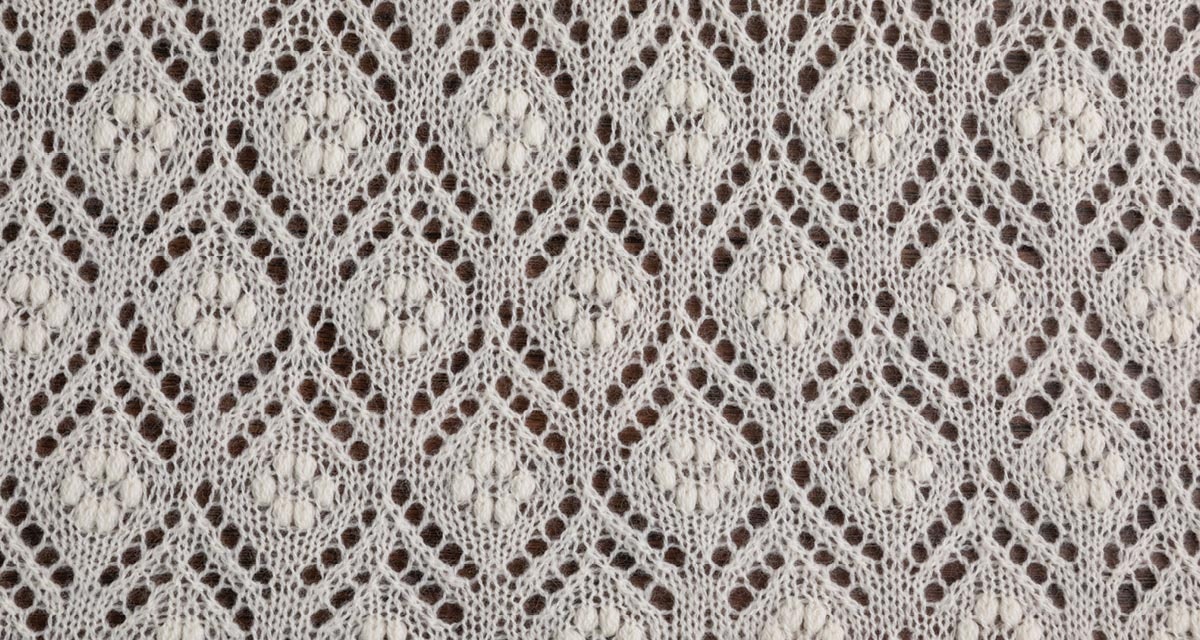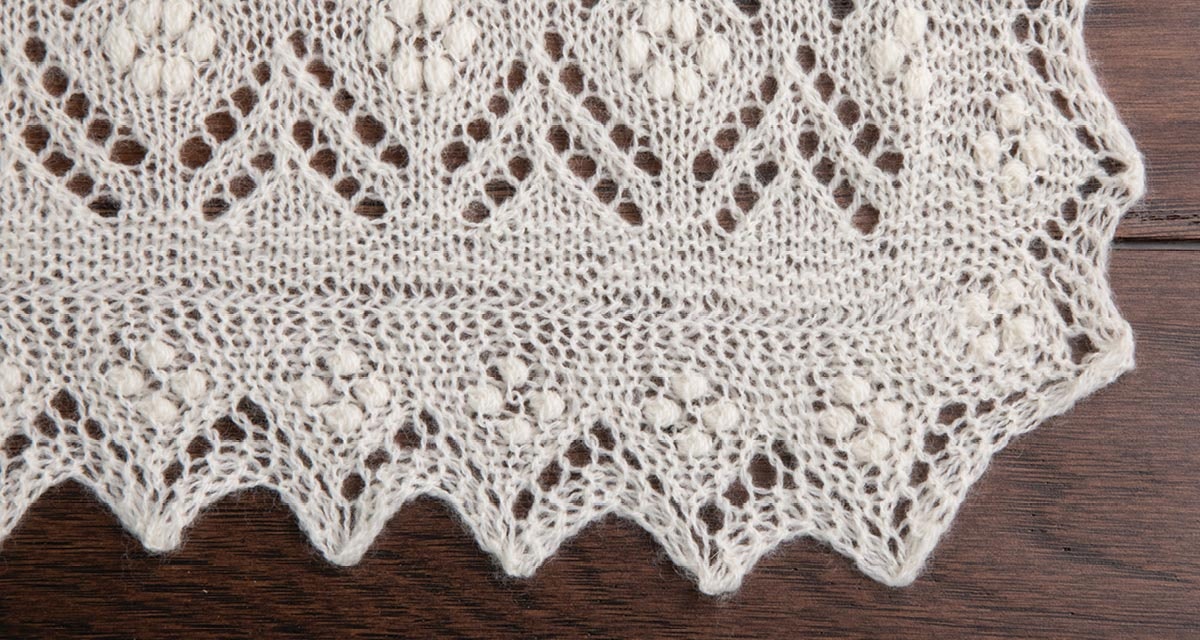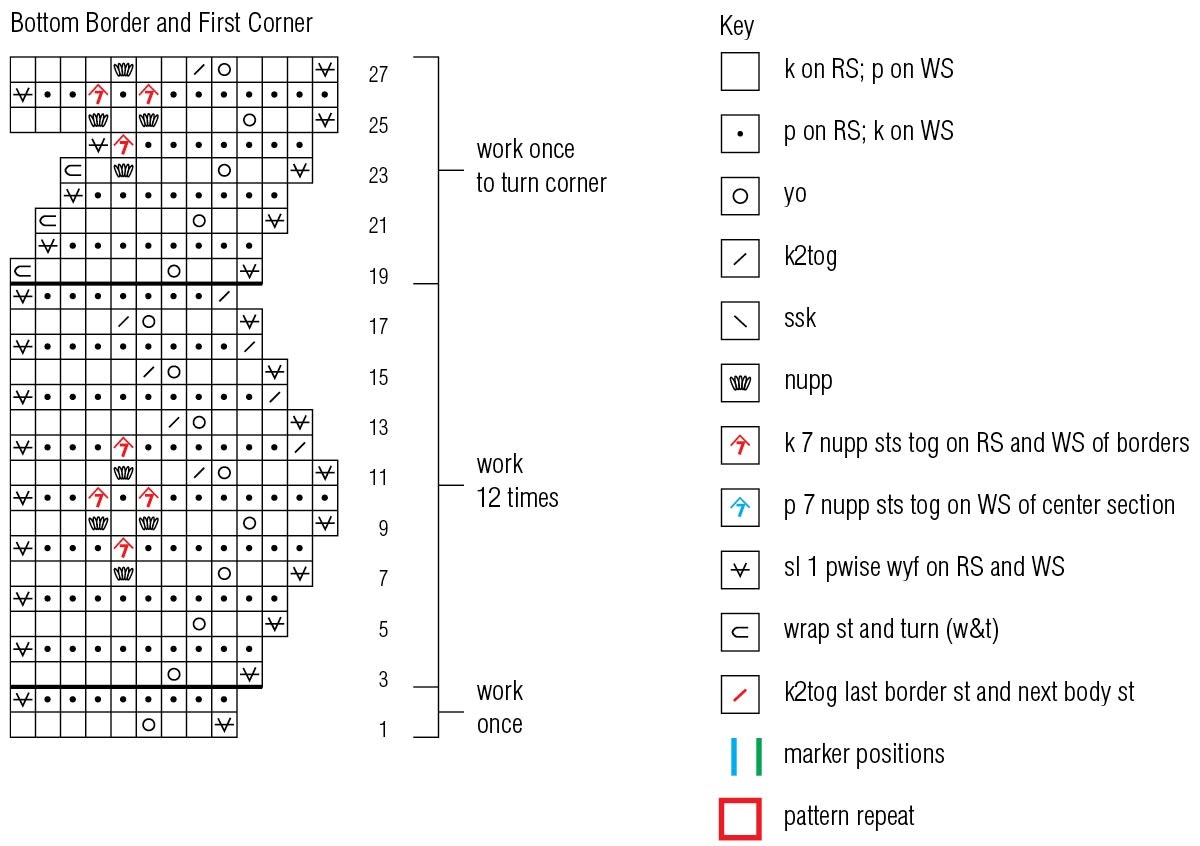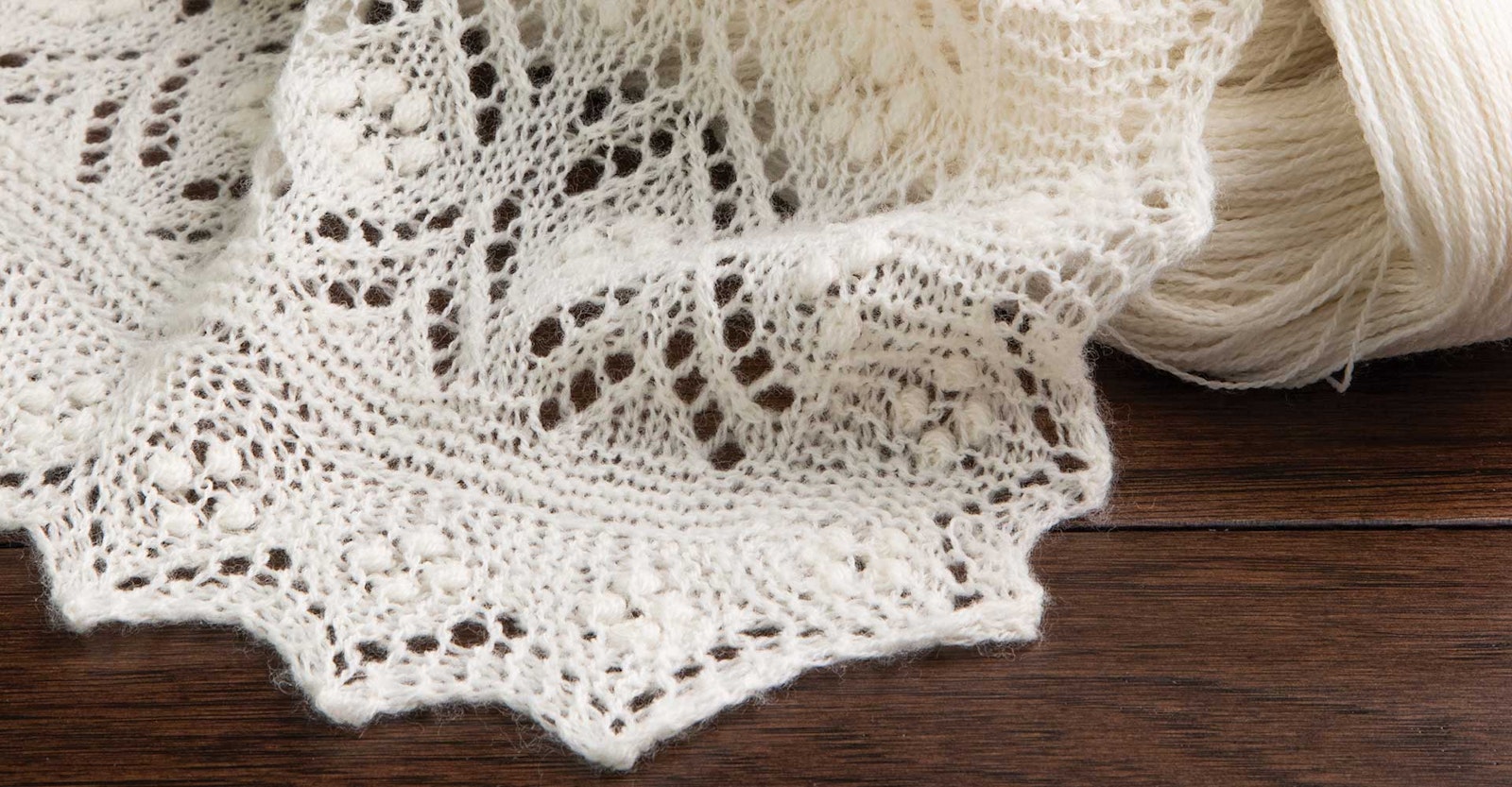Subscriber Exclusive
Flower Garden Shawl
This shawl with Orenburg construction features a fleur-de-lis pattern, to which the nupps add a three-dimensional effect.
This shawl with Orenburg construction features a fleur-de-lis pattern, to which the nupps add a three-dimensional effect. <a href="https://pieceworkmagazine.com/flower-garden-shawl/">Continue reading.</a>
https://pieceworkmagazine.com/cdn-cgi/image/format=auto/https://www.datocms-assets.com/75076/1656657842-flower-garden-shawl.jpg?auto=format&w=900
Growing up in the former USSR, I knew a lot about Orenburg lace shawls. They were considered a national treasure. For many women, owning an Orenburg shawl was a symbol of high status. There was even a song, “Orenburskyj Platok,” written about the love that went into making a shawl to warm the heart and shoulders of a beloved mother.
I originally heard about Estonian lace while living in Austin, Texas, where I attempted to knit a shawl that included nupps and fleur-de-lis motifs for the first time. I fell in love with Estonian lace, drawn in by the nupp accents and their three-dimensional effect. It was only natural that I felt that combining an Orenburg shawl structure with Estonian lace elements would make a beautiful shawl.
Editor's note: This lovely shawl can also be found in the Spring 2020 issue of PieceWork.
Materials
- Hikoo Merino Lace Light, 100% merino yarn, laceweight, 1,531 yard (1,400 m)/3.5 ounces (100 g) cone, 1 skein of #1002 Bliss (yarn distributed by Skacel)
- Needles, size 1½ (2.5 mm) circ 24 inches (61 cm) or size needed to obtain gauge
- Spare needle, size 1½ (2.5 mm)
- Markers, 2, contrasting colors
- Lace Blocking Wires (stainless-steel blocking wires and T-pins)
- Tapestry needle
Finished size: 18 inches (45.7 cm) wide and 64 inches (162.6 cm) long, after blocking
Gauge: 26 sts and 35 rows = 4 inches (10.2 cm) in lace patt from center section of Body chart, after blocking

SUBSCRIBER EXCLUSIVE
Growing up in the former USSR, I knew a lot about Orenburg lace shawls. They were considered a national treasure. For many women, owning an Orenburg shawl was a symbol of high status. There was even a song, “Orenburskyj Platok,” written about the love that went into making a shawl to warm the heart and shoulders of a beloved mother.
I originally heard about Estonian lace while living in Austin, Texas, where I attempted to knit a shawl that included nupps and fleur-de-lis motifs for the first time. I fell in love with Estonian lace, drawn in by the nupp accents and their three-dimensional effect. It was only natural that I felt that combining an Orenburg shawl structure with Estonian lace elements would make a beautiful shawl.
Editor's note: This lovely shawl can also be found in the Spring 2020 issue of PieceWork.
Materials
- Hikoo Merino Lace Light, 100% merino yarn, laceweight, 1,531 yard (1,400 m)/3.5 ounces (100 g) cone, 1 skein of #1002 Bliss (yarn distributed by Skacel)
- Needles, size 1½ (2.5 mm) circ 24 inches (61 cm) or size needed to obtain gauge
- Spare needle, size 1½ (2.5 mm)
- Markers, 2, contrasting colors
- Lace Blocking Wires (stainless-steel blocking wires and T-pins)
- Tapestry needle
Finished size: 18 inches (45.7 cm) wide and 64 inches (162.6 cm) long, after blocking
Gauge: 26 sts and 35 rows = 4 inches (10.2 cm) in lace patt from center section of Body chart, after blocking

[PAYWALL]
Special Stitches and Techniques
Wrap and Turn (w&t)
With yarn in back, slip next st knitwise, bring yarn to front, return slipped st to left needle, turn work—1 st wrapped. Work wrapped stitch together with its wrap when you next encounter it.
Nupp
Pattern row: Loosely work [k1, yo] 3 times, k1 all in the same st, then remove st from left needle—7 sts made from 1 st. On the following return row, k or p all 7 nupp sts together as instructed, being careful not to include any of the surrounding sts or sts of an adjacent nupp—7 nupp sts dec’d back to 1 st.
Russian Grafting Method
Set-up: Sl 1 st from right needle to left needle.
Step 1: Insert right needle tip into first st on left needle and draw second st on left needle through the first st and onto the tip of the right needle. Drop the first st from the left needle.
Step 2: Insert left needle tip into first st on right needle and draw second st on right needle through the first st and onto the tip of the left needle. Drop the first st from the right needle.
Rep Steps 1 and 2 until 1 st remains. Thread a short length of yarn on a tapestry needle, thread yarn through rem st, and tie a knot to prevent it from raveling.
Instructions
Notes: Visit www.pieceworkmagazine.com/abbreviations for abbreviations. Slip the first stitch of every row purlwise with yarn in front (pwise wyf), then bring the yarn to the back of the work between the needles in position to knit the next stitch.
The “toothed” borders are worked in garter stitch, and the main center section is worked in stockinette.

Alla’s shawl combines the construction of an Orenburg traditional shawl with an Estonian-style motif.
Shawl
Bottom Border and First Corner
Using the long-tail method and two needles held together, CO 8 sts, then remove one of the needles. Work Rows 1 and 2 of Bottom Border and First Corner chart once, then work Rows 3–18 twelve times—9 sts; 194 chart rows and 12 “teeth” completed. Work Rows 19–27 once to turn first corner, working wrapped sts tog with their wraps in Row 25, and ending with a RS row—13 sts (counting nupp as 1 st).
Body Pickup and Second Corner
With RS still facing, place marker (pm) at end of sts on right needle, then pick up and knit 96 sts along straight edge of lower border (about 1 st for every slipped selvedge st). Working from the zigzag selvedge toward the straight selvedge, slip the tip of the spare needle into 9 loops along the CO edge of the bottom border. With RS facing, pm on right needle, then work Row 1 of Second Corner chart over 9 sts on spare needle—118 sts; with RS facing, 13 first corner sts (counting nupp as 1 st), 96 center sts, and 9 second corner sts. Work Rows 2–9 of Second Corner chart over sts of second corner only, working wrapped sts tog with their wraps in Row 8, and ending with a RS row—122 sts; with RS facing, 13 first corner sts (counting nupp as 1 st), 96 center sts, and 13 second corner sts.
Body
Beg working across all sts.
Next row (WS): Sl 1, k3, yo, k2tog, k2, nupp, k4, sl m, k96 center sts through their back loops, sl m, k4, k 7 nupp sts tog, k6, k2tog, turn—121 sts; with RS facing, 12 right border sts, 96 center sts, and 13 left border sts (counting nupp as 1 st).
Change to Body chart. Work bottom garter frame Rows 1–6 once, work Rows 1–32 of chart 15 times, work Rows 33–48 once, then work top garter frame Rows 1–8 once, ending with a WS row—122 sts; with RS facing, 13 right border sts, 96 center sts, 13 left border sts (counting each nupp as 1 st).

Third Corner
Work Rows 1–8 of Third Corner chart over sts of right border only, working wrapped sts tog with their wraps in Row 7, and ending with a WS row—118 sts; with RS facing, 9 third corner sts, 96 center sts, 13 left border sts (counting each nupp as 1 st).
Top Border
Next row (RS): Work Row 1 of Top Border chart over first 8 sts (inc them to 9 sts as shown), sl last st to right needle, remove m, return last st to left needle, k2tog (last border st tog with first body st).
Working the last top border st tog with first body st after it, work Rows 2–16 of Top Border chart, then work Rows 1–16 eleven more times, ending with a WS row—12 top “teeth” completed; 22 sts rem; with RS facing, 9 top border sts, no center sts, 13 left border sts (counting each nupp as 1 st).
Fourth Corner
Next row (RS): Sl 1, k2, yo, k6, sl m, work Row 1 of Fourth Corner chart over left border sts—10 top border sts, 13 fourth corner sts.
Work Rows 2–8 of Fourth Corner chart over sts of left border only, working wrapped sts tog with their wraps in Row 8, and ending with a fourth corner WS row—10 sts rem on each needle; working yarn is in the center, between the two groups of sts. Break working yarn, leaving a long tail to weave in later. Use the Russian grafting method (see Special Stitches and Techniques) to join live sts together, then fasten off last st.


Finishing
Soak scarf in water until thoroughly wet, then gently squeeze out excess water. Lay flat on blocking surface. If using T-pins only, pin scarf to measurements, pinning out the point of each “tooth.” If using blocking wires, thread wires through each tooth in the same direction (either back-to-front or front-to-back), pull wires out to the correct dimensions and secure with T-pins, making sure edges are straight and parallel. Allow to air-dry completely before removing pins.

Alla Postelnik grew up in Chernovtzy, Ukraine. She learned to knit at the age of seven, when she and her mother were on a summer vacation at the Black Sea. She currently lives in Austin, Texas.







